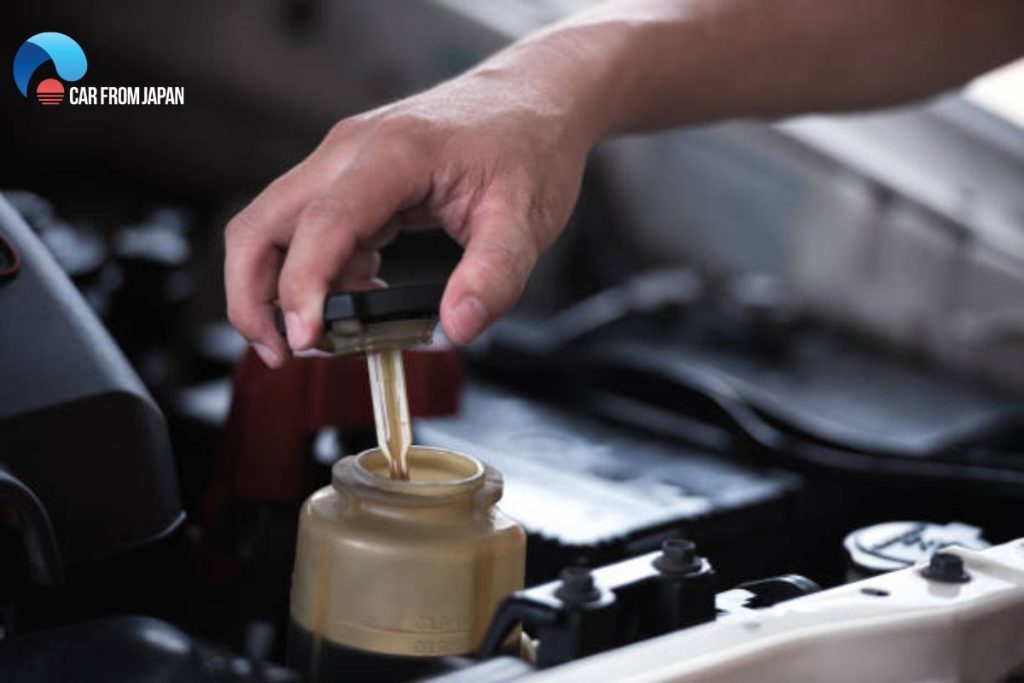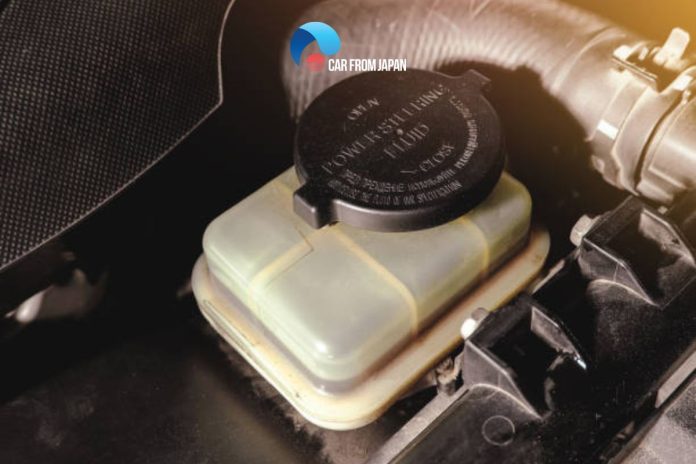Noticing your power steering fluid is low, perhaps during a routine check or after spotting a leak, naturally brings up a crucial question: “What happens if you drive the car with low power steering fluid” It might be tempting to put off topping it up or fixing the leak, but continuing to drive can lead to more than just an inconvenience. So, what are the low power steering fluid symptoms? Let’s find out with us:
Contents
Is It Bad To Drive Without Power Steering Fluid?
Power steering fluid is what allows you to turn the steering wheel with one hand, relying on the principles of hydraulics to work.
So, ultimately, can you drive without power steering fluid? The potential cause of the low power steering fluid issue is the age and use of your vehicle. As your car becomes old or reaches high mileage, the fluid of the power steering pump gets used up completely.
Consequently, you are left with no lubricating fluid for your vehicle. Also, the pump vanes produce heat lacking lubrication,n and ultimately fuse down.
In addition, the pump gets locked down and possibly damages the drive belt of the power steering. So, the shaft and rack seal also suffer injury due to the lack of steering fluid.
If you drive your car without this liquid, you can steer it, but a lot of force will be needed.
In other words, the car’s wheels can still be turned, thanks to the direct mechanical linkage still existing, but the feel of steering will be much heavier.
You might have to put a great torque on the power steering wheel, and you can sense extra resistance in your hands. Moreover, lacking this fluid also causes irretrievable harm to the steering pump.
You can notice a strange voice coming out of the pump. As a result, repairing the pump would be pricey.

Symptoms Of Low Power Steering Fluid
In a hydraulic power steering system, energy is transmitted to the steering mechanism through the use of fluid. If you were to have a low on power steering fluid, then your steering ability will be jeopardized.
To understand the full range of symptoms that you will likely experience from having a low amount of power steering fluid, here are 5 common signs of low power steering fluid you should pay attention to!
Noisy steering
Do you know how the power steering system works? The system of steering uses a pump to add pressure to the steering mechanism. Thanks to the pump, we can use and circulate the fluid to smoothen the steering process.
On the other hand, if there is less fluid and more air inside the pump, there will be a strange noise generated. And drivers can hear this when turning the steering wheel.
To fix this problem, all car owners need to do is fill the fluid reservoir with more steering fluid. You can easily find this power steering fluid in any car maintenance store, and the noise will go away right after.
If your vehicle still has a noisy steering issue, there might be other problems remaining, such as a faulty power steering pump.
Jerky or jumpy power steering
The next symptom of low power steering fluid is jumpy or jerky power steering. Whenever car owners go to rotate the steering wheel to make a turn, the steering will jump around.
For example, if you turn your steering wheel left, it might jerk to the right and then back to the left. This is, without a doubt, a very jerky and unpleasant feeling.
With some inexperienced drivers, this problem might even cause accidents. Car owners will notice this issue happening more and more as they slowly drive on the road.
It also happens when drivers turn into the parking spaces, which requires a lot of steering movement. And low power steering fluid takes responsibility for this problem.
And the worst thing about this issue is that it will not fade away in time. To make it simple, the jerkiness will only become worse and worse, so don’t let this issue continue.
Hard to turn the steering wheel
This is the most obvious symptom of low power steering fluid. If you find it hard to turn the steering wheel, we can immediately know that your vehicle has low power steering fluid.
To be more specific, your steering wheel will become very stiff and difficult to rotate or turn. This is a serious problem, and you will most likely have an accident since it will be almost impossible to drive or control your automobile the way you want.

Puddles or stains under the vehicle
Another visible sign showing that you are having low power steering fluid is the stains or puddles under the car.
If drivers ever wonder about the power steering fluid, we recommend checking to see if there is any leaking or a puddle of liquid underneath.
The liquid could be anything other than the power steering fluid. It could be oil, coolant, windshield washer fluid, or just transmission fluid.
However, if you can see the reddish color in the liquid, it might be the power steering fluid that is leaking out.
Steering wheel locks
Along with jerky or jumpy power steering, as well as a hard-to-turn steering wheel, this is the last symptom related to the wheel. If your vehicle is having a short amount of power steering fluid, you might even have a lock-up steering wheel.
And by far, this is the most crucial symptom. Imagine that you and your family are driving home happily, and then you find that your steering wheel does not rotate at all.
When you are totally out of power steering fluid, that situation would happen. So always check and notice the first 4 symptoms above and fill the power steering fluid, or else you will have a steering wheel lock.
How To Put Power Steering Fluid In A Car
There are steps you can take to add power steering fluid yourself quickly and easily. Before you start, remember to check your owner’s manual to make sure that you use suitable fluid.
Additionally, you might jack the car because it just helps you get a little bit more fluid out. But this step is optional. Advisable items you will need to do this are a catch can, a turkey baster, and tissue.
Step 1
Take the cap off of the power steering pump reservoir, then start siphoning the fluid out and get into the catch can. You can use a paper towel so that fluid doesn’t drop into your engine.
Step 2
Start the engine, turn the steering from lock to lock, then lots of old fluid will come out. Make sure that the reservoir is empty to add new fluid.
Step 3
Get a funnel so you don’t spill it anywhere and keep your paper towel down there. Your owner’s manual will tell you how much fluid you could put in. Pay your attention in order not to overfill it. Next, put the nice clean cap on.
Step 4
Start the car real quick. You can see that the fluid level drops, so you will add a little bit more and put the car on the ground.
In the following step, start it up and turn it from lock to lock to get all the air out and bleed the air out of the system.
Then, go check the fluid again and fill it up if needed. So start the engine again, on your ride, make sure you have plenty of turns that are gonna take about ten minutes just to drive around.
Remember to check your fluid in the first two minutes to make sure your fluid levels are good.
Step 5
Let your car cool down because we’re going to flush the system. Since we didn’t flush it, it is dirty again.
That’s just extra old fluid that we couldn’t get out before. Siphon out this fluid and add some more.
Be careful because now the engine is hot. You can do this as many times as you want. The more you do it, the cleaner that fluid is going to be inside.
Low power steering fluid means increased heat and friction. Hence, it can rapidly cause costly damage. So, unfortunately, the only solution left with you is to lubricate the power steering on time.
For getting more information about buying the most effective steering fluid, you can refer to some car maintenance tips by auto experts.
In extreme situations, if you still require driving without power steering fluid, it’s advisable to avoid severe turns to the right or left and restore the fluid regularly.
If not, it can seriously result in worse, unpreventable crashes that will ultimately put your life in danger.
Check out this video from Silver Cymbal to get a more visualized guide on how to put power steering fluid in just 5 mins!
Conclusion
In conclusion, driving your car with low power steering fluid is a risky practice that can lead to more than just stiff steering. You might also experience whining noises from the pump, and eventually, costly damage to the power steering pump itself. It’s always best to address low fluid levels promptly by finding and fixing any leaks and refilling the system to keep your steering smooth and your car healthy.




How do you check fluid levels for Toyota premio
How do you check fluid levels for Toyota premio.
I agree+ as the system is pressurized.
“As your car becomes old or reaches high mileage, the fluid of the power steering pump gets used up completely” ???????? this is not correct at all,power steering fluid is technically a closed system, fluid doesn’t get used up completely, degrades is the proper word, it degrades to the point you need to change it every few years and put some nice clean fresh fluid in there just like a brake system, if its getting used up completely then you have a leak and it needs fixing promptly, not trying to correct you but when you say “used up completely” it sound like the system is drinking the fluid which doesn’t happen,lol